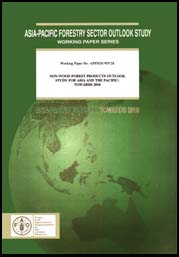
WORKING PAPER SERIES
Working Paper No: APFSOS/WP/28
by
Andrew J. Mittelman
Chun K. Lai
Neil Byron
Genevieve Michon
Esther Katz
Forestry Policy and Planning Division, Rome
Regional Office for Asia and the Pacific, Bangkok
December 1997
|
The Asia-Pacific Forestry Sector Outlook Study is being undertaken under the auspices of the Asia-Pacific Forestry Commission. This report comes under Workplan Number E25.6. |
This electronic document has been scanned using optical character recognition (OCR) software and careful manual recorrection. Even if the quality of digitalisation is high, the FAO declines all responsibility for any discrepancies that may exist between the present document and its original printed version.
INFORMATION NOTE ON ASIA-PACIFIC FORESTRY SECTOR OUTLOOK STUDY
1. SIGNIFICANCE OF NWFPS IN ASIA-PACIFIC
Purpose
NWFPs in the Asia-Pacific context
Complex and diverse nature of NWFPs
Paucity of dataHousehold importance
NWFPs and food security
Economic importance
Ecological benefits and risks
Social and cultural significance
NWFPs in ICDP approaches
A. Increasing commercialization of NWFPs
B. Declining importance of subsistence NWFPs
C. Disintegration of traditional systems
D. Devolution to community-based management
E. New policy initiatives
A. Scenario 1: Demise of NWFP supplies
B. Scenario 2: Domestication and cultivation of NWFPs
C. Scenario 3: Promoting fair trade in NWFPs
D. Scenario 4: Enabling policy environment
4. SCENARIO SETTING: SPECIFIC SITES & NWFPS
A. Rattan, almaciga and honey in Palawan, Philippines
B. NWFPs in Bulungan, E. Kalimantan, Indonesia
Historical perspective
Animals and birds
Camphor
Gaharu
Gutta percha
Illipe nuts
Damar
Rattan
Future questionsC. From extraction to production: the way ahead for NWFPs?
Harvesting from plantations: a common scenario?
Evolution from extraction to production